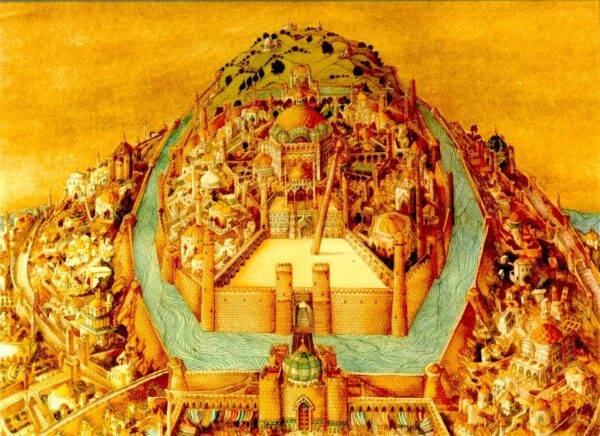Today let’s talk about the history of culture as a history of choices or the subtle beauty of The Thief and the Cobbler versus straightforward shine of Aladdin.
Yesterday I saw the Thief and the Cobbler animation film for the first time in my life. And I am pleasantly surprised. Despite its messy production history, it is still a treat to one’s eyes and mind.
The movie brings together great, yet traditional animation and an original script inspired by Arabian fairy tales. Note that the thief and the cobbler hardly interact (they meet twice and almost never talk) while acting simultaneously to contribute to a happy ending; the main villain is killed by his underdog (an underbird, to be precise).
As far as I understood, the author worked on the movie for about 30 years. He researched oriental visual art, put a lot of time and effort into his work. Hardly a surprise that he exceeded the estimate and missed all the possible deadlines. He was doing art, not business. Then Aladdin was planned by Disney and part of the team switched to this project taking some of the visual concepts with them. Actually, I’m pretty sure that The Thief and the Cobbler inspired many animators, graphic designers, CGI specialists, etc. in the movie industry over the next decades: the city reminds me of Gondor in LOTR, the inside of the war machine seems to be the source of inspiration for Van Helsing’s vampire castle, etc.
Anyway, Aladdin was released with all the possible promotion worldwide, The Thief and the Cobbler came out silently through the effort of enthusiasts and was earmarked for a limited number of connoisseurs of indie movies. As a side note, somehow it reached the Russian market, as we found a 1990s voice-over translation, but the explanation for it is omnipresence of unofficial distribution then (basically, people would buy VHS and make copies back home). But I’m digressing. The release part is where the cultural choice comes into picture, if you ask me. A generous work of art with tons of ideas is outshone by a much less sophisticated, generic thing. I’m not saying Aladdin is bad, it’s just The Thief and the Cobbler is (or could be) great. And it is one of the points where American culture cannibalized itself, as I see it. Lately I have been asking myself what has happened to the country that gave the world Jack London, O’Henry, Tennessee Williams, Mark Twain, Scott Fitzgerald, Ray Bradbury, Theodore Dreiser, Irwin Shaw and many others.
I don’t think I have an exhaustive or precise answer now, but It’s not just the invisible hand of the market. Some of the writers I mentioned were successful financially. It is also laziness and globalistic agenda. Let’s see how those work to create a negative synergy here (I love buzzwords, yeah).
The majority of modern movies (books, music, etc.) use and reuse ideas sparingly; adaptions are thrifty creativity-wise. Watching them is like chewing gum after someone else. Almost no taste left. Real art cannot be thrifty, talent is never thrifty, creativity level rises when you use it, not falls, it is not an oil-well. When thrifty art wins, culture loses, and this process is entropic in nature. It is easier to make a generic, bad or low taste movie. And when this choice of the easy path is also literally rewarded no evolution of thought is possible.
Globalistic agenda also doesn’t make doing art easier. Any book or movie is supposed to be created with lot’s of sore issues in mind. Otherwise it will not sell outside your community. There is always someone who will be offended. For example, if the Thief and the Cobbler were released now, I’m sure many would question blue eyes of an oriental princess, pale complexion of her boyfriend, her curvaceous yet slim figure, etc.
Do I think this trend in art is directly encouraged by those who don’t want people to become better and smarter through real art? I don’t know, I hate to sound like a conspiracy theorist. But, who knows. Consumption of repetitive pseudo-art definitely helps changing people into a docile crowd.



i’ve always thought of ity as an “art” vs “entertainment” binary. there can be crossover between the two but generally the creator decides if they’re making the finished “product” for themselves and art’s sake or to be marketed and merchandised.
i could mention several authors who had their work butchered for the sake of show business but alan moore always comes to mind. though they were made in sequential art format, reading “from hell” or “watchmen” (or his two gorgeous written novels) is an immersive, complex experience where repeated readings are rewarded whereas watching the movies supposedly based on them is “rewarded” with ~5 hours of your life you’ll never get back. (fun side fact: leonard cohen found the use of “hallelujah” in watchmen so cringe-inducing he declared a moratorium on its use in movies and tv shows).
that’s one of the many sad facts about being creative while working at a business: they can take the most heartfelt and poignant creations and use them any way they want as long as they hold the copyright. moore did what little he could and demanded his name be left off the watchmen tv series but the name and characters are still being recycled in new and stupid forms. the internet has helped skip these soulless middle wo/men a bit but it’s still hard to make art of any significant size without their malevolent financing.